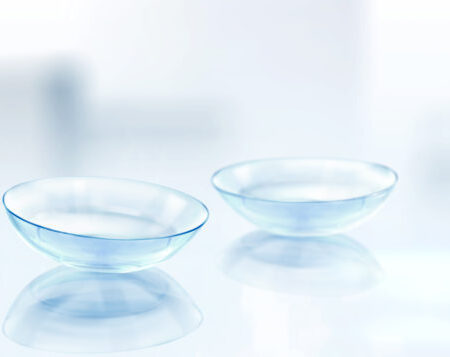Remember when you were little and your mom told you to pick out just one toy among a vast selection of enticing toys? Well, buying eyeglasses is a lot like that experience — channeling Elton John or John Lennon — such a difficult decision, we know! Selecting contacts isn’t about making a fashion statement because nobody is going to take a magnifying glass to your eyeball and say, wow, those contacts, what were you thinking! But that doesn’t mean that buying contacts is easy if you’re a first-time buyer. With so many state-of-the-art options available today, familiarizing yourself with the different types of contact lenses is a necessary first step. Like eyeglasses, contact lenses are used to correct the following vision problems:
- Myopia (nearsightedness)
- Hyperopia (farsightedness)
- Astigmatism (blurry vision)
- Presbyopia (age-related loss of close-up vision)
- Corneal irregularities
Contact Lens Terms
Toric: Used to correct astigmatism, toric lenses are shaped a little like a donut rather than a perfect sphere. While most toric contacts are soft lenses made from a conventional hydrogel or highly breathable silicone hydrogel, some are available in rigid gas permeable (RGP) materials.
Bifocal: Like eyeglasses, this has two prescriptions in the same lens to correct both near and distance vision. Bifocal lenses are alternatives to reading glasses if you have presbyopia or if you need near and far correction.
Multifocal: This type of lens is available in bifocal designs with two distinct lens powers — one for distance vision and the other for near. Other options include progressive lenses, with a gradual change in lens power that provides a natural visual transition from distance to close-up.
Hard Contact Lenses
The first hard lenses made from a type of plastic called polymethyl methacrylate (PMMA) weren’t comfortable and didn’t allow oxygen to pass through to the cornea. In the late 1970s, improvements were made in the rigid materials used to manufacture hard lenses. Contacts made from these materials are known as RGP lenses because the slightly flexible plastics allow oxygen to reach the cornea. RGP lenses correct most vision problems and are available in tints, bifocals, and multifocals.
Soft Contact Lenses
Since soft contacts were first approved by the U.S. Food and Drug Administration in 1971, great advancements have been made in the materials used. Soft contacts allow oxygen to reach the cornea, so the risk of infection is reduced with proper use. The most popular type of contacts worn today, soft lenses are available in tints, bifocals, multifocals, as well as disposables.
Soft Contact Subtypes
Daily wear: Typically the least expensive option, these contacts are worn during the day, removed at night, and placed in their contact lens case in clean solution overnight. Available in tints and bifocals, daily-wear contacts require a shorter adaption period, are more comfortable, and less prone to dislodging than hard lenses.
Extended wear: Many extended wear soft contact lenses can be worn while you sleep, for six consecutive nights or longer. Most eye experts don’t condone this practice on a regular basis because it increases the risk of eye infections. These lenses should be removed for cleaning and disinfecting at least once a week.
Disposable: Not to be confused with daily-wear contacts, daily disposables (also called one-day) come in individual packages and new ones are used each day. Daily disposable lenses are available for most basic prescriptions, astigmatism, and presbyopia correction. Although the cost is generally higher, daily disposables offer incredible convenience because you wear them once so you don’t need a cleaning solution. Weekly and monthly disposables are generally thicker than dailies, which means they are more durable and less prone to tearing. They do need to be stored in a clean case and solution every night.
Hard vs. Soft Contacts
RGP lenses are made from a firm plastic material, so they typically require a slightly longer adjustment period. And if you don’t wear them for a week, it takes a while to readjust. Due to their harder material, RGP lenses retain their shape when you blink, which tends to provide sharper vision than soft lenses. They are also more durable, so they can last for years with proper care, as long as you don’t need a new prescription. Although they don’t tear as easily, be careful not to step on them because they can break! Keratoconus (a progressive condition causing extreme visual distortion due to cone-shaped corneas) requires RGP lenses for correction, and this type of lens is also used after refractive surgery.
Soft lenses are great for active lifestyles but aren’t suitable for all vision problems. Silicone hydrogel and other state-of-the-art materials used in soft lenses delivers ultimate moisture and oxygen permeability to the eyes. Daily disposables offer unrivaled comfort and convenience.
Ultimately, the decision what contacts to wear is up to you and your eye doctor. Whatever type you choose, it’s important you get a thorough eye exam and fitting, follow all directions and schedule regular exams as recommended.
Subscribe to our email newsletter to get the latest posts delivered right to your email.

